Market
How SEC Chair Paul Atkins Will Reset US Crypto Policy
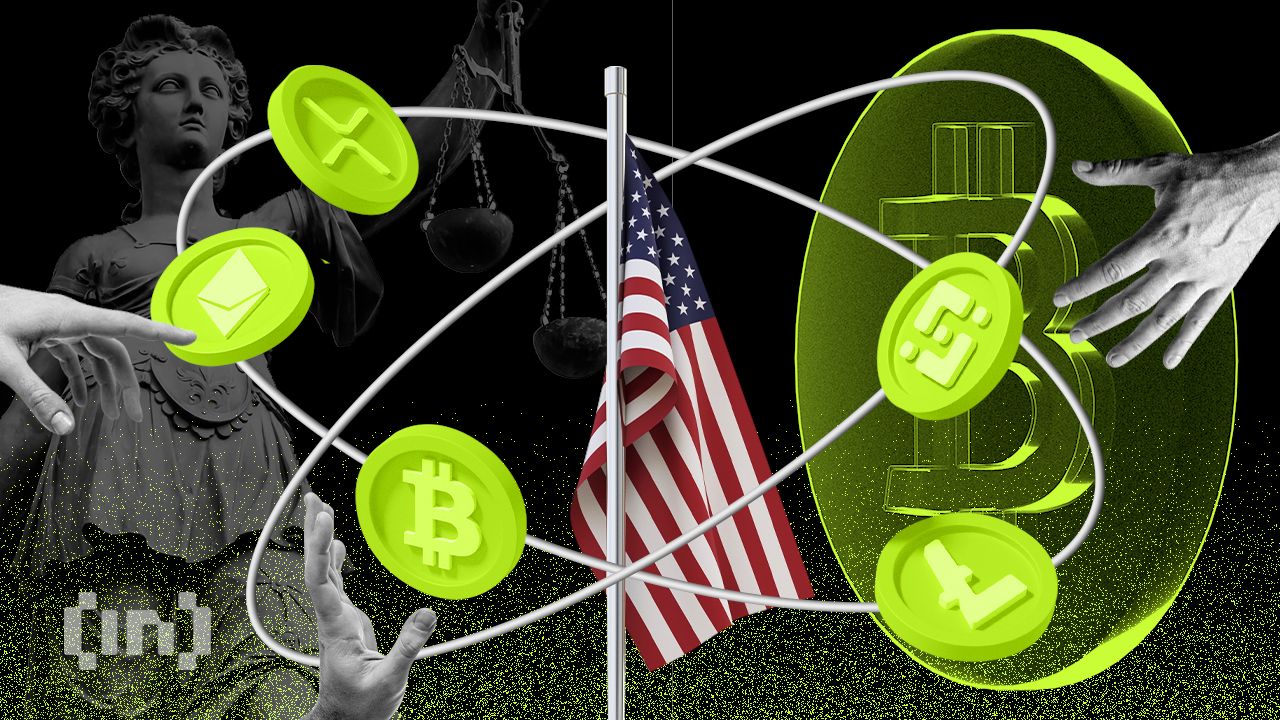
On April 9, 2025, the US Senate confirmed Paul Atkins as the new Chair of the SEC with a majority 52–44 vote. This marked a new chapter for the crypto industry in the US.
The crypto community welcomed the news enthusiastically. Atkins is widely seen as someone who will bring transparency and support innovation—unlike the heavy-handed approach of his predecessor, Gary Gensler.
Paul Atkins Will Bring Clarity and New Direction to the US Crypto Industry
In Wednesday’s episode of the Crypto in America podcast, Republican Congressman Tom Emmer—House Majority Whip and Co-Chair of the Congressional Crypto Caucus—shared his optimistic expectations for Atkins’ role in reshaping crypto policy.
Emmer expressed strong confidence that Paul Atkins will steer the SEC back to its core mission: ensuring that all Americans have access to the world’s greatest financial markets, including digital assets.
“I think Paul Atkins will bring the clarity and certainty that we need. I’ve been saying for over nine years, we need to understand what is currency, what is security, and what is a commodity. I’m sick and tired of hearing about the case law and that, oh well, you know, the attorneys, the courts—why are we doing that? We’re Congress. Why don’t we act? And I think it’ll start with the new SEC Chair, but he will give us direction much like Trump is doing with executive orders.” Emmer said.
This statement reflects the long-standing demand from the crypto industry for a clear legal framework.
Paul Atkins is well-acquainted with the SEC and the financial sector. He served as an SEC Commissioner from 2002 to 2008 under President George W. Bush. During that time, Atkins gained recognition for his pro-free market stance and efforts to reduce regulatory burdens.
After his tenure at the SEC, Atkins founded Patomak Global Partners, a consulting firm that helps crypto companies navigate complex regulatory frameworks.
Notably, since 2017, he has served as Co-Chair of the Token Alliance, an initiative of the Digital Chamber of Commerce, where he has led efforts to develop best practices for the issuance and trading of digital assets.
Atkins’ career demonstrates a deep understanding of the intersection between technology and finance. Emmer expects him to adopt a “light-touch” approach—one that focuses on supporting innovation rather than stifling it.
“I think he’s gonna make sure that that’s the SEC that we believe it should be. Gary Gensler took it off mission. What it’s supposed to do is make sure that every single American has access to the greatest financial markets on the face of the planet. And what Gary Gensler was doing was saying, well, if you’re traditional finance, you can have access. But if you’re this new digital stuff, this is bad. We’re gonna make sure that we stop you from doing anything.” Emmer said.
Emmer added that this shift in leadership could pave the way for critical legislation like the FIT 21 Act, which passed the House in May 2024 to provide clear rules for digital assets.
With support from Atkins and the Trump administration—who had pledged to make America the “crypto capital of the world”—Emmer believes Congress can soon codify these reforms into law, creating a lasting impact on the market.
Criticism of Gary Gensler: A Legacy of Obstruction
In contrast to his optimism about Atkins, Emmer did not hesitate to criticize Gary Gensler, saying that he had set “a pretty low bar” for the SEC.
“We need to have clarity and certainty in the system so investors, entrepreneurs, can, you know, take risk and innovate. And what was Gary Gensler doing? He was stopping all of that. He was telling people, my door is open. Bring any idea you got, we’re happy to talk to you about it. Well, if you were naive enough to do that, he usually sued you, or he sent you a letter that you’re under investigation afterward.” Emmer criticized.
According to a report by Paradigm, since the SEC’s first crypto-related enforcement in 2015, the agency has taken action against 171 projects and individuals.
These actions spanned three presidential terms and three confirmed SEC chairs. Nearly half of them—88 cases—occurred under Gensler’s leadership.

Emmer also pointed out a striking contradiction in Gensler’s approach to meme coins, often criticized as vehicles for fraud.
“I heard a lot of complaints about meme coins yesterday during the hearing… But you realize Gary Gensler is the one that said, this is what we could use meme coins for. He’s the one that actually empowered the creation of meme coins the way we see it right now… If you don’t like it, stop complaining about it, and let’s figure out how we can put some guardrails on that.” Emmer revealed.
His remarks emphasized Gensler’s failure to provide guidance—instead choosing to criticize and punish. With Atkins, Emmer hopes to reverse that trend. He envisions an SEC that doesn’t just enforce but enables the crypto industry to grow within the United States.
A New Era for Crypto Policy
According to Tom Emmer, Paul Atkins’ appointment is more than a change in leadership. It’s an opportunity to reset crypto policy in America. Atkins could be the catalyst for Congress to turn reforms into reality—and, more importantly, to keep crypto businesses in the US rather than driving them overseas.
With a clear and supportive approach, Atkins could transform the SEC into an agency that champions the digital financial future rather than blocking it.
If successful, the crypto industry may be entering a new era of unprecedented growth under his leadership.
Disclaimer
In adherence to the Trust Project guidelines, BeInCrypto is committed to unbiased, transparent reporting. This news article aims to provide accurate, timely information. However, readers are advised to verify facts independently and consult with a professional before making any decisions based on this content. Please note that our Terms and Conditions, Privacy Policy, and Disclaimers have been updated.
Market
Is The XRP Price Mirroring Bitcoin’s Macro Action? Analyst Maps Out How It Could Get To $71
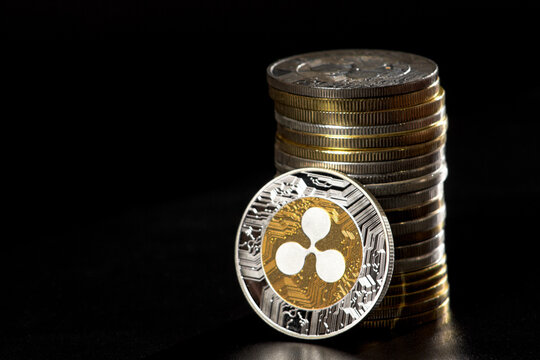
Reason to trust

Strict editorial policy that focuses on accuracy, relevance, and impartiality
Created by industry experts and meticulously reviewed
The highest standards in reporting and publishing
Strict editorial policy that focuses on accuracy, relevance, and impartiality
Morbi pretium leo et nisl aliquam mollis. Quisque arcu lorem, ultricies quis pellentesque nec, ullamcorper eu odio.
A crypto analyst has presented a compelling case, suggesting that the XRP price may be closely mirroring Bitcoin’s historical macro action. By comparing its multi-year chart patterns and market behaviour, the analyst argues that XRP may be gearing up for a significant price rally to $71 and beyond.
XRP Price Traces Bitcoin Path To Reach $71
TradingView crypto analyst RizeSenpai has forecasted that XRP could surge explosively to $71. At its current market price, this would represent a staggering 3,281% increase.
Related Reading
The TradingView expert conducted a detailed comparative analysis, drawing striking similarities between Bitcoin’s breakout from its multi-year accumulation range in 2015-2017 and XRP’s current price structure. He points out that XRP’s movements since it was listed on Poloniex in 2014 have closely mirrored Bitcoin’s macro price action but at a slower rate, estimated at 65%.
For emphasis, the price chart shows that Bitcoin experienced a sharp surge of 5,424% after consolidating between 2013 and 2016 and finally breaking out in 2017. Similarly, XRP had a big rise in 2017 but has since been stuck trading within a large multi-year range for nearly six years as of the end of 2022.
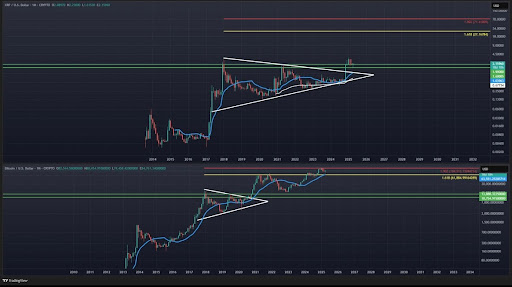
Recently, XRP broke out of its long-term price range and has been consolidating above its old all-time high resistance for several months. Considering its current price action, the analyst assumes that the asset may be attempting to move toward new breakout levels.
The TradingView analyst has highlighted the potential for XRP to surge toward a more realistic target of $27 – $30, near the 1.618 Fibonacci Extension level. For reference, he shared a chart comparing Bitcoin’s past bull market breakout and performance with XRP’s current breakout and future price action.
The chart reveals that when BTC broke out, it surged toward the 1.618 Fibonacci level at $61,800 before initiating a secondary run that topped at the 1.902 HOP level. As a result, RizeSenpai predicts that if XRP can completely mirror Bitcoin’s performance, it could skyrocket to $27, potentially reaching as high as $71, where the 1.902 HOP level lies.
The Token To Surge Above $71 To $120
As mentioned earlier, XRP is still trading within a multi-year range breakout similar to Bitcoin’s in its past cycle. As of writing, XRP’s price sits at $2.13, having declined by more than 11% over the last month.
Related Reading
Notably, if the altcoin replicates the breakout momentum previously seen in Bitcoin, RizeSenpai predicts an explosive 5,400% increase, pushing its price to a very ambitious target of $120.94. This suggests that the TradingView analyst believes that XRP could exceed its previously projected target of $71 and climb past $120.
Adding to the weight of this bullish forecast is the presence of a monthly Moving Average Convergence Divergence (MACD) Hidden Bullish Divergence. This technical indicator is often associated with an uptrend continuation and potential upside momentum.
Featured image from Adobe Stock, chart from Tradingview.com
Market
Ondo Finance (ONDO) Rises 3.5% Following MANTRA Crash

Ondo Finance (ONDO) is showing renewed strength, up more than 4% in the last 24 hours, with trading volume jumping nearly 13% following the collapse of MANTRA’s OM token. This shift in capital appears to be favoring other RWA-focused projects like ONDO, which is now gaining momentum across several technical indicators.
A golden cross has just formed on the EMA lines, while both the DMI and CMF suggest growing bullish pressure and fading selling interest. As sentiment recovers, ONDO could be gearing up for a breakout toward the $1.20 mark if key resistance levels are cleared.
ONDO DMI Chart Shows Buyers Are In Control
ONDO’s DMI (Directional Movement Index) chart shows that its ADX has declined to 28, down from 36 two days ago, indicating that the strength of the recent trend is beginning to fade.
While an ADX value above 25 still suggests a solid trend is in place, the drop reflects weakening momentum after a period of strong directional movement.
This shift could mean the market is entering a phase of consolidation or hesitation as traders reassess ONDO’s next move.

The +DI (positive directional index), which tracks upward price pressure, is currently at 25.17—up from 21.1 yesterday but still down from 31.18 two days ago.
Meanwhile, the -DI (negative directional index), which measures downward pressure, has dropped to 14.36 from 18.86 yesterday, though it remains higher than its 10.56 reading from two days ago.
This combination suggests that bullish pressure is regaining some ground in the short term, even as the overall trend strength cools off.
For ONDO, this could mean a potential recovery attempt is forming, but unless ADX stabilizes or rises again, the trend may remain fragile and susceptible to quick reversals.
ONDO CMF Is Growing After Touching -0.17
ONDO’s Chaikin Money Flow (CMF) is currently at -0.06, a sharp recovery from -0.17 just one day ago.
The CMF is a volume-based indicator that measures the buying and selling pressure of an asset over time, using both price movement and trading volume.
Values above 0 indicate net buying pressure, while values below 0 reflect net selling pressure, helping to gauge the strength of market sentiment.

Although ONDO’s CMF remains slightly negative, the rapid shift toward the zero line suggests that selling pressure has significantly weakened, and buying interest may be starting to return.
This surge could be linked to a shift in investor sentiment following the collapse of MANTRA’s OM token, as capital may be rotating to other RWA coins like ONDO.
While the current CMF still shows a cautious tone, the upward move signals improving market confidence that, if sustained, could support a further price recovery.
Will ONDO Reclaim $1.20 Soon?
ONDO’s EMA lines have just formed a golden cross, a bullish signal that often marks the beginning of a fresh upward trend.
This technical development suggests growing upward momentum, with a potential test of the $0.956 resistance level likely in the near term.
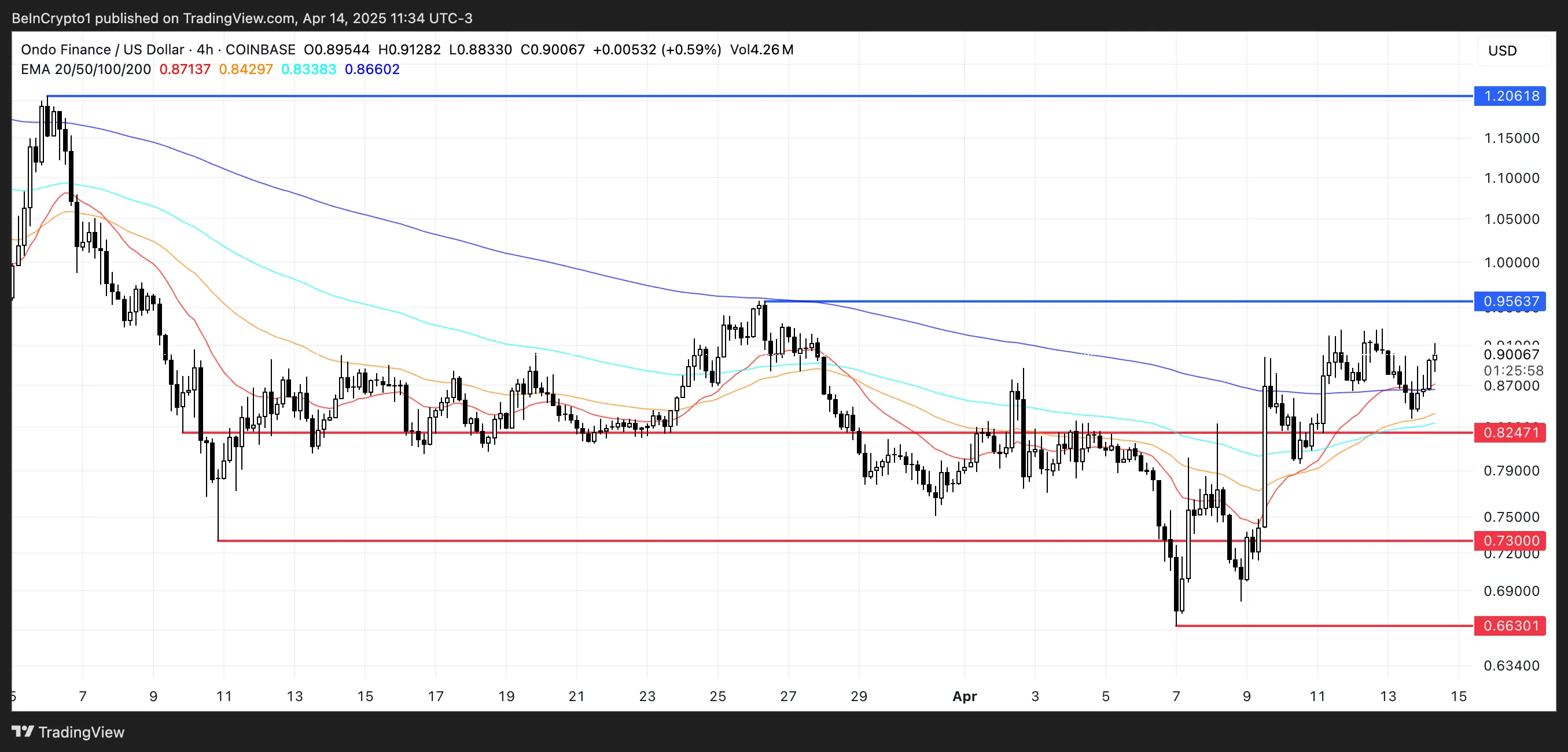
If that resistance is broken, ONDO could gain further traction and rally toward the $1.20 mark, reinforcing bullish sentiment and drawing in more buyers.
If the RWA coin fails to maintain its current momentum and the price drops below the key support at $0.82, selling pressure could intensify.
A breakdown below that level could lead to a deeper correction toward $0.73, and if that zone doesn’t hold, it may slide further to $0.66.
Disclaimer
In line with the Trust Project guidelines, this price analysis article is for informational purposes only and should not be considered financial or investment advice. BeInCrypto is committed to accurate, unbiased reporting, but market conditions are subject to change without notice. Always conduct your own research and consult with a professional before making any financial decisions. Please note that our Terms and Conditions, Privacy Policy, and Disclaimers have been updated.
Market
Binance Futures Causes a Brief Crash For Story (IP) and ACT
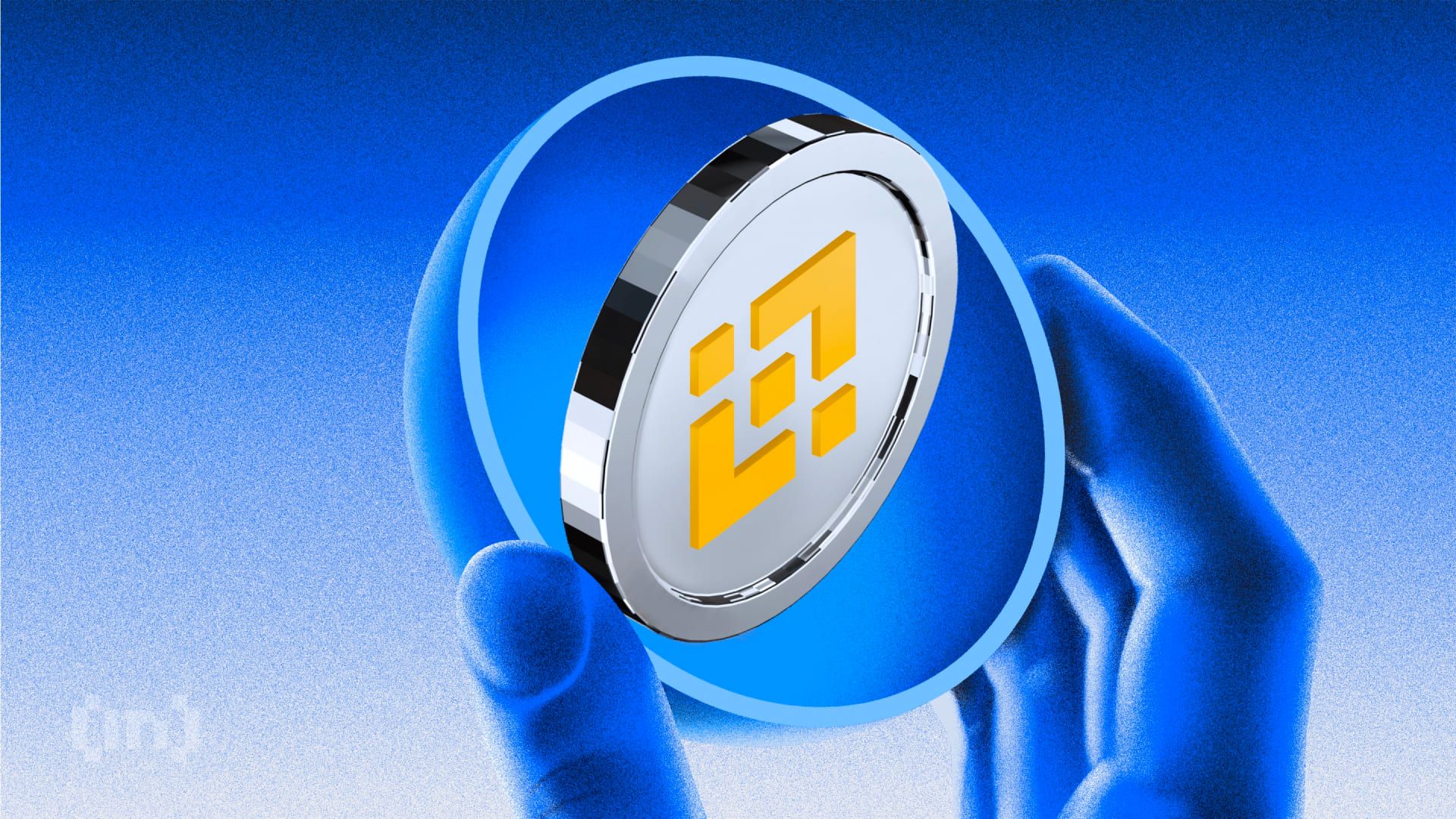
Story (IP) and The AI Prophecy (ACT) token saw a massive 20% crash and subsequent rebound earlier today. The exact trigger is unclear, but the pattern has been linked to high trade volumes on Binance Futures.
Despite the recovery, the sudden drops were concerning, as MANTRA’s OM token crashed 90% yesterday, and its co-founder blamed Binance.
ACT and IP, two largely unrelated token projects, saw similar patterns of crashing and rebounding at the same time. The exact trigger is unclear, but the pattern has been linked to high trade volumes on Binance Futures.
Why Did ACT and IP Suddenly Crash and Rebound?
Binance Futures is a popular trading platform launched by the world’s largest crypto exchange, and its listings can spike the prices of various assets.
Today, however, the community is left with many questions, as speculation on Binance Futures apparently caused ACT and IP to tank in price.

ACT is an AI token, and IP aims to put intellectual property on the blockchain. Both of these tokens plummeted rapidly, by 27% and 21.5%, respectively.
However, they both managed to shoot back up after, with ACT even having a net 24-hour growth of 2.5%. IP has been a top-performing asset for several months, and its sudden drop sparked fear among holders. The subsequent recovery suggested the volatility was short-term.
According to Coinglass data, over 1.27 million ACT futures trades were executed on Binance—more than double the second-highest exchange, BingX. Binance also holds over $20.4 million in ACT futures open interest.

This concentration makes Binance a critical price discovery engine. When large positions are quickly liquidated—often triggered by stop-losses, margin calls, or algorithmic trading—it can create an outsized impact on underlying token prices.
Futures markets now frequently surpass spot markets in volume and velocity. While this enhances liquidity, it also increases fragility.
A liquidation cascade—where long positions are forcefully closed due to declining prices—can accelerate downward momentum. Today’s synchronized drop in both IP and ACT suggests that excessive leverage and crowded positions may have triggered such a cascade on Binance.
These moves reaffirm that token prices, particularly for emerging or mid-cap assets, are increasingly shaped by derivatives markets. As more projects are listed on futures platforms early, volatility driven by short-term positioning rather than long-term value creation is becoming the norm.
Disclaimer
In adherence to the Trust Project guidelines, BeInCrypto is committed to unbiased, transparent reporting. This news article aims to provide accurate, timely information. However, readers are advised to verify facts independently and consult with a professional before making any decisions based on this content. Please note that our Terms and Conditions, Privacy Policy, and Disclaimers have been updated.
-

 Market18 hours ago
Market18 hours agoBitcoin’s Price Under $85,000 Brings HODlers Profit To 2-Year Low
-

 Altcoin11 hours ago
Altcoin11 hours agoAnalyst Predicts Dogecoin Price Rally To $0.29 If This Level Holds
-

 Altcoin15 hours ago
Altcoin15 hours agoBinance Breaks Silence Amid Mantra (OM) 90% Price Crash
-

 Market14 hours ago
Market14 hours agoXRP Outflows Cross $300 Million In April, Why The Price Could Crash Further
-

 Market24 hours ago
Market24 hours agoMANTRA’s OM Token Crashes 90% Amid Insider Dump Allegations
-
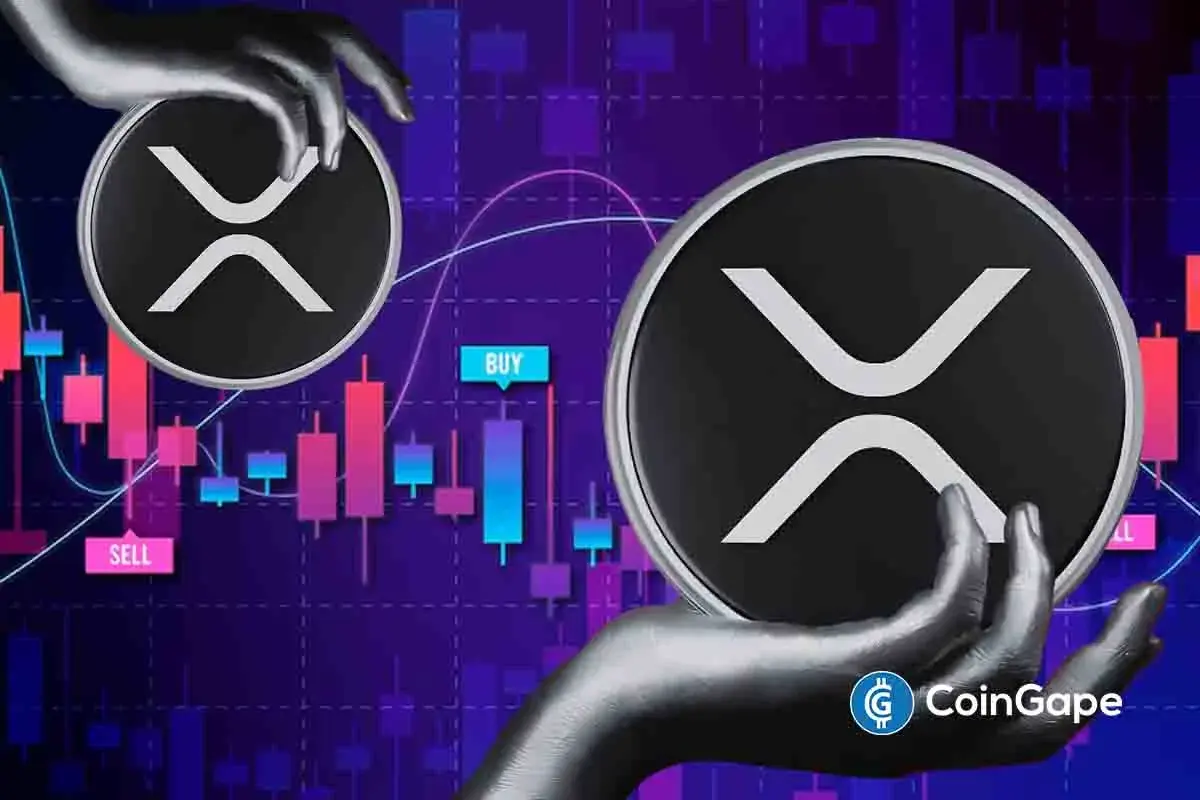
 Altcoin12 hours ago
Altcoin12 hours agoXRP Price Climbs Again, Will XRP Still Face a Death Cross?
-

 Market13 hours ago
Market13 hours agoFLR Token Hits Weekly High, Outperforms Major Coins
-

 Bitcoin13 hours ago
Bitcoin13 hours agoCrypto Outflows Hit $795 Million On Trump’s Tariffs & Market Fear





















